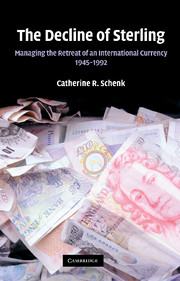Book contents
- Frontmatter
- Contents
- List of figures
- List of tables
- Acknowledgements
- 1 Introduction
- Part I Reconstructing the International Monetary System 1945–1959
- Part II Accelerating the Retreat: Sterling in the 1960s
- 4 Sterling and European integration
- 5 The 1967 sterling devaluation: relations with the United States and the IMF 1964–1969
- 6 Sterling and the City
- 7 Multilateral negotiations: sterling and the reform of the international monetary system
- 8 The Sterling Agreements of 1968
- Part III Sterling's Final Retreat 1970–1992
- Index
8 - The Sterling Agreements of 1968
Published online by Cambridge University Press: 04 May 2010
- Frontmatter
- Contents
- List of figures
- List of tables
- Acknowledgements
- 1 Introduction
- Part I Reconstructing the International Monetary System 1945–1959
- Part II Accelerating the Retreat: Sterling in the 1960s
- 4 Sterling and European integration
- 5 The 1967 sterling devaluation: relations with the United States and the IMF 1964–1969
- 6 Sterling and the City
- 7 Multilateral negotiations: sterling and the reform of the international monetary system
- 8 The Sterling Agreements of 1968
- Part III Sterling's Final Retreat 1970–1992
- Index
Summary
Chapter 7 has established that successive British governments in the 1960s used multilateral frameworks to try to relieve the pressure that the reserve role of sterling posed. By identifying sterling as an issue of concern to the stability of the international monetary system as a whole, they sought to spread the burden of retreat. They met resistance from both the United States and Europe in the G10 context, but this did not imply an abandonment of this strategy. Although it failed in the G10 and the IMF, the United Kingdom was successful in engaging the Bank for International Settlements in sharing the risks inherent in reducing the reserve role of sterling, and this laid the prerequisite for bilateral negotiations with holders of sterling in the summer of 1968 that transformed the nature of official sterling reserves. The BIS provided a forum for negotiations among central bankers separate from the political wrangling of governments that so hampered the G10 negotiations.
The outcome was two sets of agreements. Under the Basle Agreement the G10 central banks agreed to provide a safety net line of credit of $2 billion on which the Bank of England could draw to offset declines in its central reserves due to the diversification of overseas-held sterling reserves. As a quid pro quo, they insisted that the United Kingdom negotiate bilateral Sterling Agreements with thirty-four countries to keep a minimum proportion of their reserves in sterling over the term of the Basle Agreement.
- Type
- Chapter
- Information
- The Decline of SterlingManaging the Retreat of an International Currency, 1945–1992, pp. 273 - 314Publisher: Cambridge University PressPrint publication year: 2010



